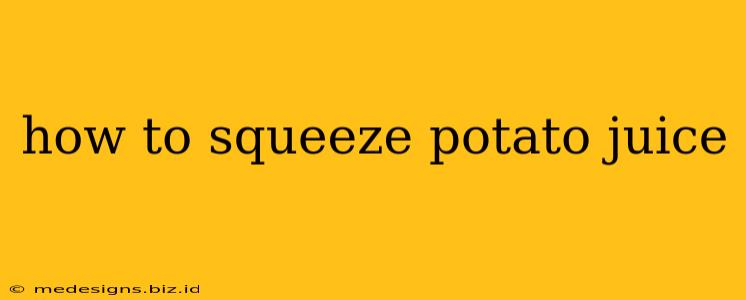Want to unlock the potential of potato juice for its purported health benefits or culinary uses? Knowing how to effectively extract the juice from potatoes is key. This guide provides various methods, from simple hand-squeezing to using kitchen appliances, ensuring you get the most out of your potatoes.
Why Squeeze Potato Juice?
Before diving into the methods, let's understand why you might want to extract potato juice. Potato juice has gained popularity for several reasons:
- Potential Health Benefits: Some believe potato juice offers benefits like improved digestion, boosted immunity, and even skin health improvements. (Disclaimer: Always consult your doctor before using potato juice for medicinal purposes. These are potential benefits and not guaranteed results.)
- Culinary Uses: Potato juice can add a unique flavor and moisture to certain dishes, acting as a natural binder or ingredient enhancer.
Methods for Squeezing Potato Juice
Several methods can help you extract potato juice, each with its advantages and disadvantages:
1. Manual Squeezing (The Old-Fashioned Way)
This method is simple and requires no special equipment.
- Step 1: Preparation: Wash and peel your potatoes thoroughly. Grate them using a box grater or food processor. The finer the grate, the easier it is to extract the juice.
- Step 2: The Squeeze: Place the grated potatoes in a clean cloth (cheesecloth works best). Gather the corners of the cloth and tightly squeeze, applying firm pressure to extract the juice. You may need to do this in batches depending on the quantity of potatoes.
- Step 3: Strain (Optional): For a smoother juice, strain the extracted liquid through a fine-mesh sieve to remove any remaining pulp.
Pros: Simple, inexpensive, no special equipment required. Cons: Time-consuming, can be messy, may not extract all the juice.
2. Using a Juicer
This is the most efficient method for larger quantities.
- Step 1: Preparation: Wash and peel your potatoes. Cut them into smaller chunks suitable for your juicer's size.
- Step 2: Juicing: Feed the potato chunks into your juicer according to the manufacturer's instructions. Most centrifugal juicers work well for potatoes.
- Step 3: Enjoy! Collect the freshly squeezed potato juice.
Pros: Efficient, extracts a significant amount of juice, faster than manual squeezing. Cons: Requires a juicer, cleaning the juicer can be time-consuming.
3. Blender Method (Followed by Straining)
A blender can be used as a helpful intermediary step.
- Step 1: Preparation: Wash and peel your potatoes. Cut them into smaller pieces that fit easily into your blender.
- Step 2: Blending: Blend the potatoes until a smooth puree is formed. Add a small amount of water if needed to help with blending.
- Step 3: Straining: Pour the blended mixture into a cheesecloth-lined sieve or a nut milk bag. Squeeze firmly to extract the juice.
Pros: Can handle larger quantities, reasonably efficient. Cons: Requires a blender and straining process.
Tips for Maximizing Potato Juice Extraction
- Choose the Right Potatoes: Russet potatoes are generally good for juicing due to their higher water content.
- Fresh is Best: Use fresh potatoes for the best results.
- Don't Over-Juice: Over-squeezing can sometimes result in a bitter taste.
- Storage: Store extracted juice in an airtight container in the refrigerator. It's best consumed fresh, but can last for a couple of days.
Conclusion
Squeezing potato juice can be easier than you think! Whether you opt for manual squeezing, a juicer, or the blender method, remember to prioritize cleanliness and freshness for the best possible results. Experiment with different methods to find what works best for you and your kitchen. Remember to always consult with a healthcare professional before incorporating potato juice into any health regimen.
